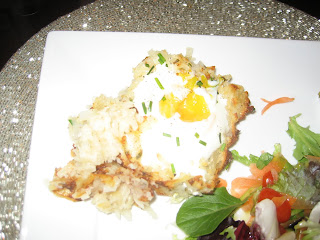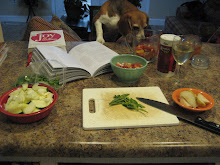If you take a look at all of the items on tonight's menu, you may wonder about the "mini" description. It's only because I grew up attending fish fries hosted by my grandparents, which fell after Christmas and before their annual trip to Florida for the winter. They no longer take the trips, but the fish fry has become a family tradition and includes fried oysters, fried scallops, fried white fish of any kind caught by my grandfather and friends, shrimp cocktail, scalloped potatoes, cole slaw, bread, green beans, homemade pickles, and a bevy of desserts. So, by comparison, tonight's meal seemed, well, smaller.
If you choose to replicate this menu, just keep in mind a few things: the remoulade and fish need some time to chill in the refrigerator, so plan to do some prep work at least two hours in advance. Also, it may seem like a lot of individual parts, but once cooking actually began, I had everything plated and on the table within 50 minutes.
The Menu:
Parmesan-Pecan Fried Catfish with Remoulade Sauce
Garlic-Roasted Potatoes
Garlic-Infused Lima Beans

I started with a remoulade sauce I pulled from a Tabasco cookbook I bought the hubby for Christmas. (The cookbook accompanied his personalized bottle of the red pepper sauce, so yeah, we're fans.) This type of mustard-based sauce is great as a condiment to any fried fish.
Remoulade Sauce1/4 c. spicy coarse-ground mustard
2 tsp. paprika
1 tsp. Tabasco
1 tsp. salt
1/2 tsp. freshly ground black pepper
1/4 c. tarragon vinegar
1 c. olive oil
1/2 c. coarsely chopped green onions
1/2 c. finely chopped celery
In a medium bowl, whisk together the mustard, paprika, Tabasco, salt, and pepper. Beat in the vinegar and then, whisking constantly, add the oil in a slow, thin stream, continuing to beat until the sauce is thick and smooth. Stir in the green onions and celery and mix well. Cover the bowl and let stand for at least 2 hours before serving.
Next I prepped the
Parmesan-pecan fried catfish, using 1.5 pounds of catfish cut into one-inch thick strips, dropping the strips into a large Ziploc bag and pouring in 1 cup of buttermilk (or place both ingredients in a shallow pan and cover with plastic wrap). I then let the fish sit in the refrigerator for one hour.
We moved on to an appetizer next, something we rarely do, but having recently purchased some habanero jelly, I decided to spread a layer of softened cream cheese on a plate and top it with the jelly, serving with Triscuits. If you like heat, habanero jelly is a great addition to your pantry.

After appetizers and before pulling out the fish, I prepped the
garlic-roasted potatoes, another recipe pulled from the Tabasco cookbook:
2 russet potatoes, cut into one-inch cubes and blotted with a paper towel to remove excess water
1-2 tbsp. olive oil
1-2 garlic cloves, thinly sliced
salt to taste
1 tsp. Tabasco
Preheat the oven to 400 degrees. Toss together all ingredients and place in a large roasting pan (or a lightly greased baking sheet could also be used). Roast for 30 minutes, stirring once halfway through cooking time. (Potatoes are finished when a fork easily pierces through a test potato.)
At the same time I started roasting the potatoes, I heated the vegetable oil in a Dutch oven (a cast iron skillet can also be used), pouring oil to a depth of 1.5 inches and heating to 350 degrees. (If you do not have a cooking thermometer, you can test the heat level by adding a few drops of water to the oil; if it spatters, then the oil is ready.) While waiting for the oil to heat, I removed the catfish from the buttermilk, discarding the latter. For the coating, I used:
2 eggs, lightly beaten
Pecan Mixture (following ingredients were stirred together in a shallow bowl):
1 c. ground pecans
2/3 c. plain yellow cornmeal (if you have self-rising yellow cornmeal mix, it works just as well)
2/3 c. grated Parmesan cheese
1 Tbsp. Cajun seasoning
1 Tbsp. paprika
Dip the fish in eggs and dredge in the pecan mixture, shaking off any excess. Place the strips on a baking sheet lined with parchment paper or aluminum foil and set aside until you're ready to start frying the fish. (Note: you can add salt if you feel it is necessary, but it's really not thanks to the natural saltiness of the Parmesan and the Cajun seasoning.)
Prior to the 15-minute halfway roasting point on the potatoes, I added 10 oz. frozen
lima beans, 1 c. water, 2 tsp. minced garlic, 1 Tbsp. olive oil, and salt to taste to a sauce pan and started cooking on medium, covering for the duration of cooking time. Just keep an eye on the beans to make sure there is adequate water in the pan.
After checking and stirring the potatoes and returning to the oven for their remaining 15 minutes, I dropped into the Dutch oven the coated catfish, frying in batches for 2-3 minutes. It's important to avoid overcrowding the Dutch oven (or cast iron skillet)--if you try to stuff in as many pieces as you can, it results in a significant drop in the frying temperature, which means uneven frying and a much less appetizing crust. Catfish fries quickly, but if you're worried about the "doneness" of the fish, just insert a fork, and the meat should easily flake. If not, just drop back into the oil for a few more minutes.
After all of the catfish strips are fried, the lima beans and potatoes should be finished as well. Just plate up with the remoulade as a dipping sauce and serve.

To finish our evening, we split a lemon cupcake we purchased from a cupcake bakery in Roanoke. At some point, I'll try to replicate this, but for now, I'll take the break from cooking tonight!
















































